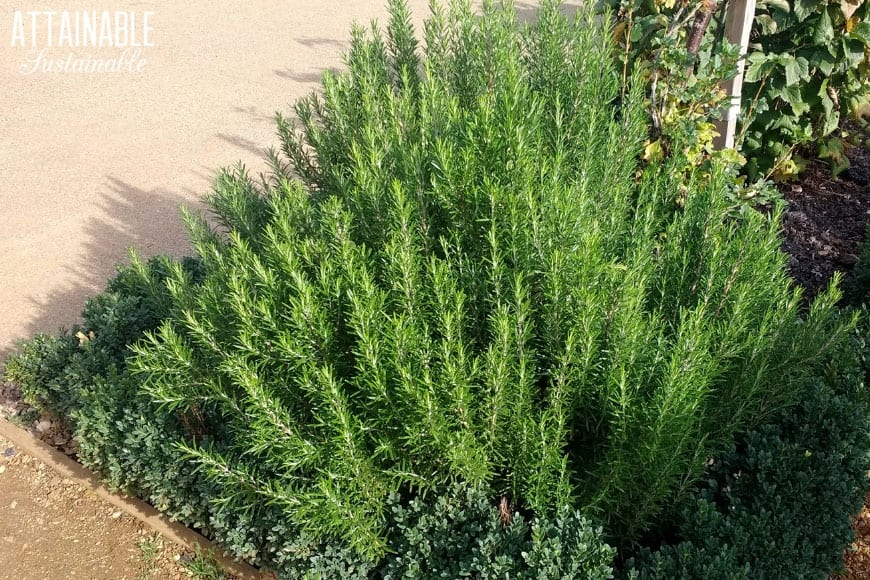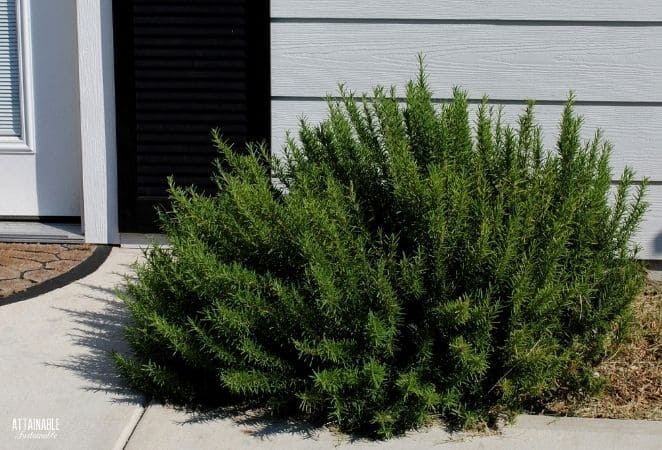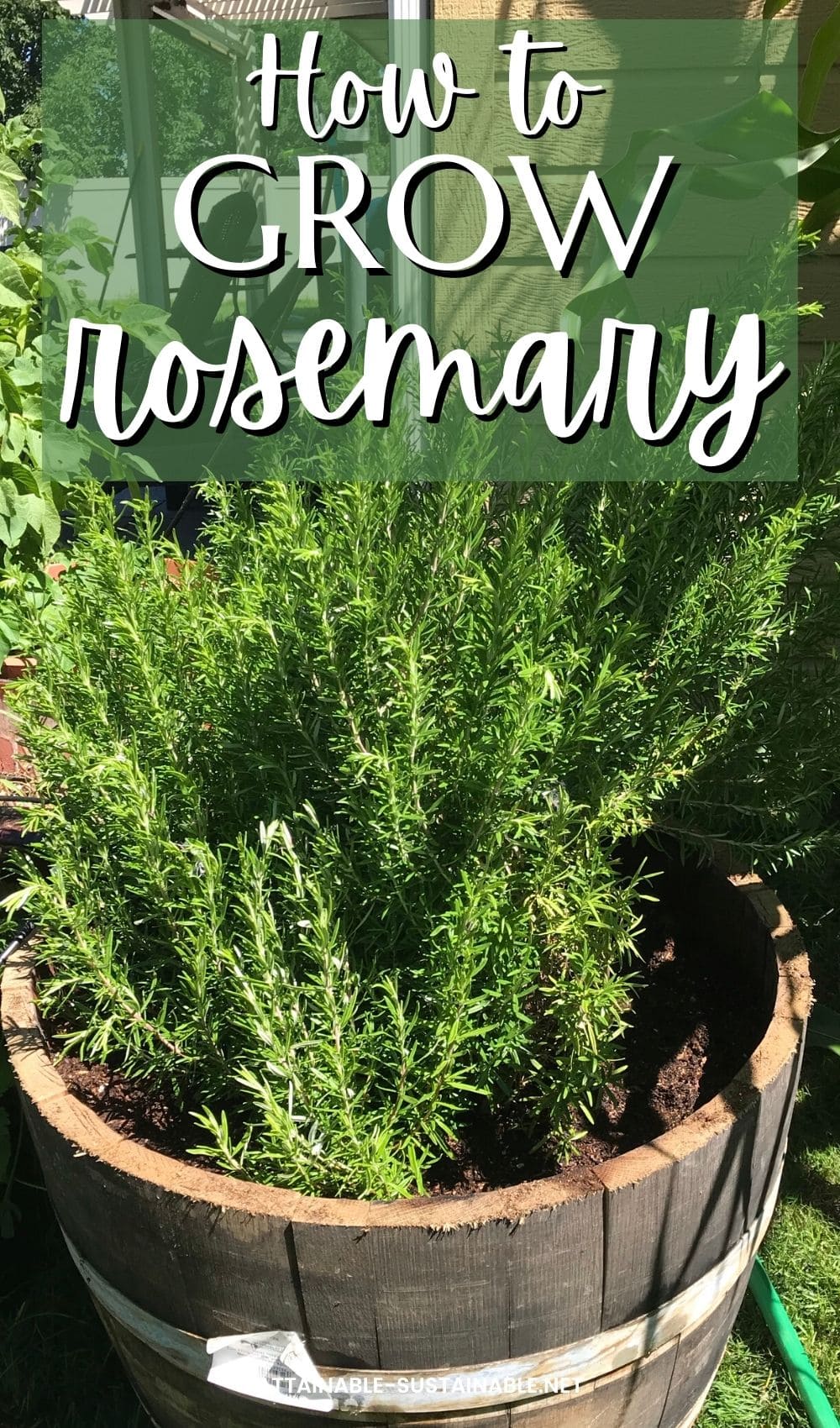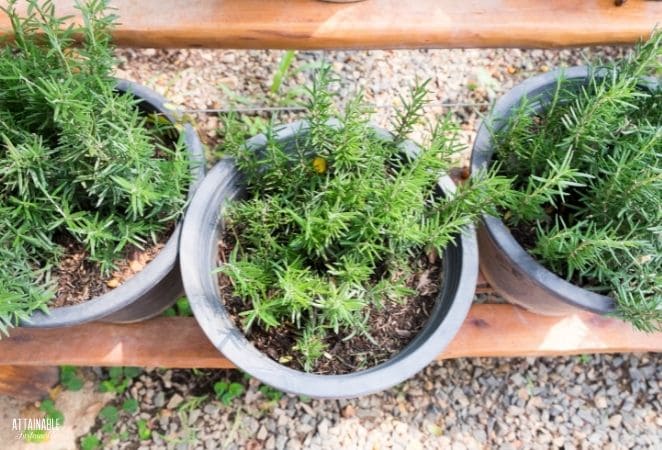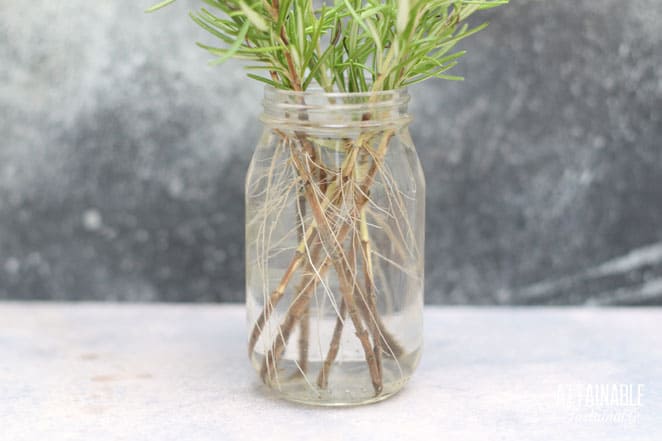If you love the bold flavor of rosemary in your meals, consider growing rosemary in your garden! It’s a great addition to herb gardens and valuable as a drought tolerant landscape plant as well.
Read more about drought tolerant gardening to save water!
Contributed by Jodi Torpey, author and Master Gardener.
The herb known as rosemary is actually a tender perennial evergreen shrub that’s been valued for its culinary, medicinal, and ornamental uses since about 500 B.C. From flavoring foods to its use as a cure for health problems from headaches to dandruff, rosemary has always had an important role as a multi-purpose plant.
Rosemary is a Multi-purpose Plant
Most gardeners who grow rosemary today use the savory herb’s dark green aromatic leaves to add earthy flavor to all kinds of recipes. It also makes a fragrant houseplant with hints of lemon and pine.
After being listed for hundreds of years as Rosemarinus officinalis, in 2019 the United Kingdom’s Royal Horticultural Society (RHS) decided rosemary deserved a name change to Salvia rosmarinus.
Grow Some Greens!
Ready to grow fresh greens, no matter WHERE you live? Sign up for my
FREE quick-start guide and start growing some of your own food!
The thinking was that instead of being two separate species of plants, rosemary and sage are more similar than believed when the plant was first named in the 1700s. This change to its scientific name means gardeners might want to keep that in mind when shopping for seeds and plants.
In warm climates, like its native Mediterranean, rosemary can be trained to grow into a dense hedge thanks to its shrubby nature. Under ideal conditions, rosemary can grow to 30 inches tall or taller and just as wide. In addition to its attractive needle-like leaves, plants bloom with tiny pink, white or blue flowers in summer.
In cold-weather regions, rosemary is typically grown as an annual, although it might be perennial if planted in a warm microclimate that’s protected from drying winds. Rosemary also grows well when planted in containers that make it easy to bring plants indoors for winter.
Rosemary is one of those plants that can adapt to any spot in the garden. You can plant rosemary in the herb garden with other fragrant herbs like sage, lavender and tarragon; add plants to the perennial garden as an accent; or plant in the vegetable garden with beans, cabbages and carrots.
Three Rosemary Varieties for Your Garden
Foxtail is one variety of rosemary that features fine foliage with a striking plume-like habit. The plant offers the typical rosemary fragrance and flavor, with the added benefit of flowers that bring pollinators to the garden; 1-3 feet tall and hardy to zones 8-10.
Arp is the variety to choose for cold-weather regions. This variety of rosemary offers extra-long seasons of fresh herbs with gray-green foliage that can grow over 3 feet tall; hardy to zone 5.
Growing rosemary from seeds is less common than staring with plants or cuttings, but SimplyHerbs is the rosemary for gardeners who like to start their gardens from seeds. Seed pellets simplify planting and help ensure seed-starting success. Plants grow 12-24 inches tall; hardy to zone 7.
Planting and Growing Rosemary
While some gardeners find growing rosemary from seed challenging, it can be done with time and patience. Start seeds 8-10 weeks before the average last frost date for your region or allow that amount of time to get plants to the transplant stage. Seeds need to be kept moist and bottom heat from a heat mat will help with germination.
Because of the lengthy amount of time to get seeds to sprout and grow, most gardener opt for planting rosemary transplants. Seed and garden catalog may have rosemary listed with other garden herbs, but you may find plants in the perennials section, too.
Wait for the night-time temperatures to warm to a consistent 50-55 degrees before planting. Give rosemary plants room to grow, spacing between 24-36 inches apart or plant rosemary in containers. Larger varieties may need even more space.
Requirements for Growing Rosemary
Soil Requirements
Because of its Mediterranean roots, rosemary prefers a warm, dry soil that’s well-draining. If soil stays soggy, roots have a tendency to rot causing plants to decline. Amend clay soil with compost or other organic matter to ensure water drains quickly.
Light Requirements
Plant rosemary in a site where it gets full to partial sun and where it’s sheltered from wind. Rosemary can be a finicky plant when conditions are less than ideal.
Fertilizer and Water Requirements
Rosemary plants are easy to care for if you feed about once a month with a water-soluble fertilizer. A balanced fertilizer will help to keep plants healthy and growing those fragrant dark green leaves.
Keep up with moderate watering and watch for any problems associated with too much water, such as wilting or yellowing leaves. Use your finger to test the soil before watering to make sure soil is dry.
Be sure to keep leaves healthy by watering at soil level only.
Prevent Rosemary Problems
Soggy soil is the quickest way to a rosemary plant’s decline. Roots can rot when soil is too wet, so make sure to water only when the soil is dry to the first few inches.
Allow air to circulate around rosemary plants by giving plants enough space to grow to their full height and width. Prune branches to help plants maintain a good upright form.
Growing Rosemary in Pots
If growing in containers, make sure the container is large enough to support the mature plant and that it has holes in the bottom for drainage. Use a quick-draining potting mix for containers and mix in a slow-release fertilizer before planting.
Add a water-soluble fertilizer to the watering can about once a month to keep plants green and heathy.
You can also plant rosemary in a smaller container to bring inside during the winter to grow as a houseplant, just be sure to inspect plants for insects that may hitch a ride indoors. Growing rosemary indoors allows you to snip that fresh flavor all winter long! [More on growing herbs indoors.]
How to Harvest Rosemary
Harvest rosemary leaves by snipping stems and stripping the leaves. Rosemary can be used fresh for a variety of recipes or dry the stems, remove the leaves and store in an air-tight container for later use.
How to use Rosemary in the Kitchen
Rosemary adds a warm piney taste to recipes, whether used fresh or dried. This aromatic herb adds spice to vinegars, infuses butter with a wonderful flavor, and makes a nice tea. Rosemary can be used in marinades, dressings, stuffing, and rubs for grilling; complements meat (especially lamb), fish, pasta, egg, and vegetable dishes; and adds a surprising new taste to breads, soups and stews.
Rosemary isn’t just for savory recipes; you can use it a seasoning for fruit salads and jellies. If you’re crafty, you can use rosemary to create a pomander to add a pleasant scent to a closet or drawer.
How to Propagate Rosemary
The easiest way to propagate rosemary is by using a cutting of soft or new wood from a mature rosemary plant.
You’ll need a clean, sharp garden pruner; small container; well-draining potting mix; a plastic bag and a saucer.
Here are the basic steps for propagating a rosemary cutting:
- Cut a 2- to 3-inch piece of rosemary from an actively growing plant.
- Strip the leaves from the bottom 2/3 of the cutting to leave about 6 leaves.
- Plant the cutting in a container filled with moist potting mix and cover the container with the plastic bag to hold in moisture.
- Place the container on a saucer in a spot that gets indirect light.
- Watch for new growth; remove the plastic and give the plant time to get acclimated to indoor or outdoor conditions.
- Transplant your new rosemary plant to a larger container or to a sunny spot in your garden.
For a more detailed look at propagating rosemary, read this!


